540 SHAPING THE SHEEP DOGS
SHAPING THE SHEPHERDS' DOGS
by David Hancock
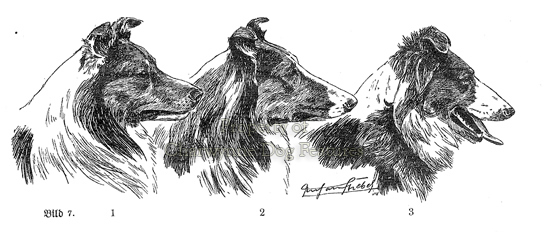 “Unfortunately, far more recently than this date (i.e. the end of the eighteenth century, DH), infusions of different blood were introduced into the Collie, usually to satisfy a whim for a special point: the cross with the Gordon Setter was made to enrich the tan; with the Irish Setter in a misplaced attempt to enrich the sable; with the Borzoi to increase the length of head. As a result of the Irish Setter cross the words ‘setter red most objectionable’ came to be included in the earlier standards of the breed, and even today we all too often see the horrible results of the Borzoi cross in the receding-skulled, roman-nosed horrors which masquerade under the name of Collie.”
“Unfortunately, far more recently than this date (i.e. the end of the eighteenth century, DH), infusions of different blood were introduced into the Collie, usually to satisfy a whim for a special point: the cross with the Gordon Setter was made to enrich the tan; with the Irish Setter in a misplaced attempt to enrich the sable; with the Borzoi to increase the length of head. As a result of the Irish Setter cross the words ‘setter red most objectionable’ came to be included in the earlier standards of the breed, and even today we all too often see the horrible results of the Borzoi cross in the receding-skulled, roman-nosed horrors which masquerade under the name of Collie.”
From The Popular Collie by Margaret Osborne, Popular Dogs, 1960.
Cosmetic Reasons
The above quote reveals one consistent element – all the outcrosses were made for cosmetic not functional reasons. Now that breed health, breed purity and instructions to show ring judges are all receiving much merited attention, there is one extremely important aspect of pedigree dog breeding and showing that deserves attention. It would be sad if we lost breeds to the perpetual pursuit of prettiness backed by prolonged inbreeding, more than regrettable if we lost breeds to rogue genes and monstrous if judges rewarded exhibits displaying harmful exaggerations. But sad, regrettable and monstrous too if our precious breeds are bred to the wrong template; the show ring has changed a number of breeds, not for the better; fashion, fad and pressure from influential kennels can impose a changed type on a breed. Gradual changes, viewed initially as slight exaggerations, develop into bigger ones, reactions to docking in breeds not previously docked and ‘the fashion of the day’ can all contribute to the classic fundamental type in a distinctive breed being reshaped. This reshaping can be whimsical in origin, untraditional in effect, even harmful in its manifestation, but as time passes, can become acceptable. Damage by design causes as much discomfort and distress to dogs as many health problems.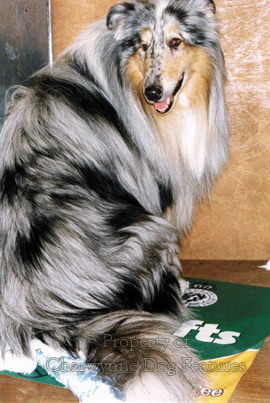
The shape of a breed, its physical form or morphology, should result from its functional design, be protected by its breed standard, guarded by its breed clubs and treasured across the generations of breed devotees as its unique identity. But all too often breed points become breed exaggerations as close breeding overplays its hand. In this way, long ears become ground-draggers, short legs become castors, long spines become centipedal, long coats become overcoats, slack eyelids become dustpans and short muzzles become dental and respiratory handicaps. It is easy to argue that the Kennel Club should be overseeing breed-continuation or protecting the morphological integrity of a breed, if only on health grounds. But the first stop is surely the breed clubs; the KC should look over their shoulders and may have failed to do so. But that shouldn’t let breed clubs off the hook. Who allowed the Collie-Borzoi cross? Who watched as the Shetland Sheepdog became more coat than dog? Who allowed the Welsh Corgi’s legs to all but disappear? How did the two varieties of Shetland Sheepdog (rough and smooth) merge into just the one whilst the bigger Scottish dog was allowed to become two breeds in those two coats? In 1909 the Sheltie was expected to be twelve inches high; now its ideal height is put at 14 and a half inches. Is that for the better of the dogs? Who let the Bearded Collie disappear under a mighty rug of coat? Who was supervising the well-being of dog breeds when all this change was being inflicted?
Pointing the Finger
Who decides the narrowness of the Collie’s skull? Who advises on the jaw-length of a healthier Shetland Sheepdog? How high off the ground should the Corgi’s torso be? What is unacceptably long in the leg-length of a Corgi? Who will prevent the Collie’s muzzle from becoming too snipy? Are the little differences between the Cardigan and Pembroke Corgis worth perpetuating or are they just breed-vanity? Why does the Old English Sheepdog need to have a ‘rather short body’? Has this led to its Standard under Gait/Movement to need the words: ‘some dogs may need to pace’? This is not sound movement in any working dog. Who decides the weight of a Pyrenean Mountain Dog, a breed council, or, one day, an animal rights group! There is a clear need for an Ofmorph, an official to monitor shape, an inspector of canine morphology! But who would he be, how would he operate and with whose authority? No one person could have all the skills involved, it would need a combination of canine historian, veterinary anatomist and functional advisor to work on the morphology of each subject breed for the betterment of that breed. More interference in breed business? Greater outside intrusion in breed matters? Even more bureaucracy for breeders and breeds to cope with? Truly there are greater dangers in not having such a person; untraditional and harmful alterations have already been made to our precious breeds. Comparison between depictions of breeds when they were first developed and photographs of their descendants today are revealing and what they reveal is not always flattering to a breed’s alleged ‘improvement’ in the show arena. Old depictions may lack pictorial quality and the subject dogs may lack ‘glamour’ but they illustrate breed type and a functional anatomy only too well.
Respecting the Past
The physical form or morphology of each breed of pedigree breed really needs safeguarding, it can preserve true type, it can restore functional type, it can achieve a healthier breed. A morphologist could ensure that a breed standard contributes to the health of that breed. Photography too has given us a simply marvellous tool in the conservation of true type in dogs. Of course each breed changes subtly as the years go by, but truly who wants a breed to change its appearance fundamentally ~ only those not skilful enough to breed to the standard or more wallet-led than honest. Historic photographs can show you what you don’t want in a breed – if you respect its past and the pioneer breeders who devoted their lives to the best interests of such breeds. 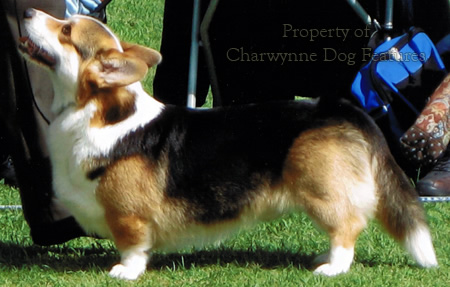
The Bateson Inquiry into pedigree dog breeding in Britain considered such an aspect, recording in its recommendations the need ‘to avoid extremes of conformation that create welfare problems’. An informed morphologist would soon spot an Old English Sheepdog handicapped by sheer weight of coat or see a grossly over-bulked Pyrenean Mountain Dog, just a warm-blooded obstacle. A Corgi with its keel on the ground is no longer a cattle-dog, just an animated draught-excluder. These are ancient breeds, quite admirable breeds deserving of both our compassion and our best endeavours, not grumpy opposition based on contemporary lazy thinking. The Kennel Club may actually be better placed to monitor design flaws than the Department for the Environment, Food and Rural Affairs or Defra, as Bateson recommended. The KC appoints judges and publishes breed standards. Making them responsible for harmful breed design, actionable in the courts, could work wonders. When those in authority create welfare problems, the first resort should always be the firm insistence that it is they who must remedy their neglect and accept responsibility for remedying the sad situation created in fact by them. New bodies take time to achieve results; the design of quite a number of our dog breeds urgently requires reshaping; make the KC right their wrongs! Pressure them into accepting responsibility!
Loss of Type
What is the correct type for each of our native pastoral breeds? Is the less refined head illustrated in the trials dogs of, say, the 1930s the true type for the Border Collie breeders to exemplify? Is the type shown of several of our native breeds, say, in the accurate depictions by the artist Arthur Wardle in his sketches of the late 1800s? He was extraordinarily gifted in capturing breed type in his work on dogs and for this was favoured by many late Victorian and then Edwardian writers and publishers. Sometimes loss of type is easier to spot than the preservation of genuine type. But what exactly is type? The KC defines it, in its Glossary of Terms, as ‘The characteristic qualities distinguishing a breed’. But are those qualities physical, mental or in temperament? Baker, in his The Collie of 1900, wrote that: “It is extremely difficult to define in words the general outline and symmetry of a Collie, but it may be summed up in one word ‘type’.” Again, not conclusive, precise or particularly instructive. My definition would be on these lines: Type is the manifestation in a breed of those particular innate physical and mental characteristics that, without exaggeration, distinguish the traditional form that a breed should take. In using these words I am seeking to preserve and perpetuate the character and conformation that was stabilised and then established when distinct breeds evolved – nearly always in pursuit of a specific function. Every breed needs type to define its identity.
In 2011, the fanciers of the Pyrenean Mountain Dog produced a brief but quite excellent, well-illustrated brochure on their breed, valuable because of its remarkable honesty and as an admirable example to other breed fanciers whose breed has temporarily gone ‘off the rails’. In it they argue that true type and the essence of the Pyrenean is being lost in the British show ring. They stress that the show ring must not promote selection on the grounds of fashion and exaggeration. They considered that fashion was winning over true type, mainly through judges who have never learned or who have lost sight of the breed’s original purpose. They point out that over the years, the handsome, working, ‘rustique’ dog has been steadily replaced by a glamorous over-coated and back-combed dog. They remind fellow fanciers that any dog able to work on high, exposed mountainsides must have a lean and muscular build and a weatherproof coat, and they end with a plea for them to respect the ‘dog of the mountains’. I salute them for this publication and applaud their criticism of judges who resort, in their after-show critiques, to words such as ‘cobby’ and ‘upstanding’ that simply do not reflect the Breed Standard for the breed.
Over the years, however, the critiques written by judges at conformation shows have revealed the state of the pastoral breeds all too starkly, indicating not just unsound breeding but also a sad loss of basic type in so many breeds. It’s worth looking at the wording of some of these, past and present:
By William Arkwright, (a highly experienced and very knowledgeable sporting dog expert) in his judge’s critique on Collies in The Kennel Gazette of November, 1890: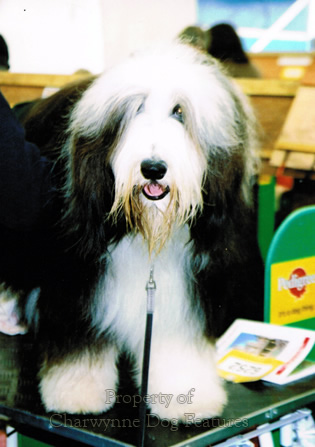
SHEEPDOGS
“I thought these were wretchedly bad. I had not looked at these dogs for about eighteen months, and I was shocked at their deterioration in type, in character, and in structural formation. I fear the unfortunate sheepdog has fallen into bad hands, and very soon the true animal will be a thing of the past.”
From the annual report on Collies, written by Trefoil, The Kennel Gazette, January,1891:
“During the past year, the premier honours of the show bench have again and again gone to dogs of this greyhound type whose faces bore an inane expressionless look, whose coats were soft and woolly, their bodies weedy and supported on stilt-like legs. These creatures tell their own tale of humiliation as they gazed into one’s face with their miserable look: ‘We are being improved off the face of the earth.’ That is exactly what is going on, and breeders and judges, with a few exceptions, are joining hand in hand in the work of destruction.”
By the judge of Collies, Manchester Dog Show, May, 1888:
“The collie classes were all well filled, and there was an absence of ‘the mongrel’, only one St Bernard (or a relative) being exhibited, but many of the exhibits looked as if they had been brought up in town.”
(JJ Steward, The Kennel Gazette, June, 1888).
By SE Shirley, writing the critique on Collies at the Kennel Club’s 35th Show in The Kennel Gazette of April, 1891:
“Writing generally, I may be allowed to express a sincere hope that Collie breeders will pause before they commit themselves to so dangerous an innovation as a weak, narrow-headed, brainless Collie, the animal that of all others should excel in intelligence and capacity of intellect.”
By the judge of Bearded Collies at a Championship (Ch) Show in 2012: “I penalised wide fronts, coarse/heavy shoulders and short upper arms, these faults being commonplace in some that have been winning…Far too much emphasis is placed on looks and not on make-up”
Priority given to Type
Many breeders of pedigree dogs in Britain put 'type' at the top of their list when it comes to placing, in order of priority, their breeding desiderata. Despite that, it is disappointing to note just how many breeds have lost their essential 'typiness' over the years. Breeds like the Shetland Sheepdog, the Rough and Smooth Collies, the two Corgi breeds and the Bearded Collie get less and less like the early specimens of the breed with each generation. If you study depictions of Queen Victoria’s Rough Collie Darnley II you can see at once how this breed has been changed by show ring criteria. On the other hand, breeds like the Border Terrier, the Deerhound, the Curly-coated Retriever, the Dalmatian, the Schipperke and the Pug seem able to resist human whim and retain the truly traditional look of the breed. Exaggerations exaggerating themselves play a part, as the Collie’s head illustrates. Unwise blueprints play a role too, as the 100+ words on the head and skull of the Collie demonstrate increasingly each year. For me, there are two very simple criteria to be brought to bear here. Firstly, if you admire a breed and respect its ancestry, why make it look like something different? To do so is an entirely irrational act. Secondly, if you love dogs and one breed above all others, how can you possibly justify breeding dogs of that favoured breed with an anatomy which is not only quite unlike that of their ancestors but one which threatens their health and well-being? To do so lacks any real affection, merely indicates self-interest and the absence of any real empathy with subject creatures.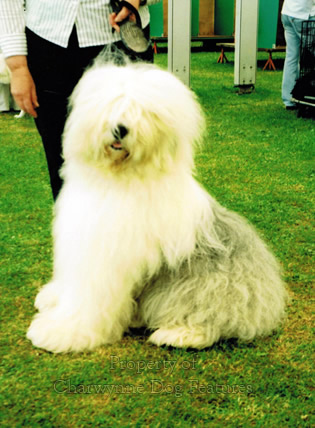
The great expert on the Old English Sheepdog, HA Tilley wrote, in his booklet on the breed (undated but Florence Tilley kindly gave me a copy in 1981) of the cramped outlook of those who maintain that this, that, or the other dog represents ‘the best type’: “Such restricted opinions are usually based on personal fancy, or an obeisance to some current fashion which pays more attention to aesthetic considerations than to utility value…If someone asked me to select for him a well-bred and trained OES, my first question would be: ‘What kind of work do you want him for?’ If the reply were, ‘General work about the farm, but more particularly for sheep’, I should then ask, ‘Is your farm dry or hilly, or low-lying and on the ‘wet side’ from late autumn to spring-time?’ If he answered, ‘Mainly high and dry,’ one would advise a dog of rather less than medium height, i.e. not more than 20 inches in height, whereas for heavier conditions a bigger and stronger one would be desirable. In either case each would be ‘true to type’, but the final choice would be determined by the nature of the surroundings in which the dog would be required to work.” Such wisdom is not common in today’s show-biased world, in which breeds are so often shaped by ‘prominent breeder’s whim’.
Poor Conformation
Type can manifest itself in movement and stance; it is unwise to try to ‘stack’ every breed identically in the ring or to expect a common gait between breeds. I have seen judges try to correct a Border Collie in the ring for proceeding in a stealthy crouch, a style totally in keeping with the breed. The Greater Swiss Mountain Dog has to have a 10:9 body length to height ratio; if not ‘stacked’ naturally this ratio is disturbed. The Shetland Sheepdog has all but lost its forechest, lying in front of the point of shoulder, but crafty ‘stacking’ can conceal this fault. I see Shelties too with their legs too short but made to stand ‘tall’. I expect to see a ‘show of pads’ when the Corgi is being moved in the ring; when it is not displayed I strive to look closer. I see GSDs over-reaching when ‘gaited’ and sometimes they even win a ticket. This is a serious fault in a working breed. But unless the dog moves crab-wise or not straight ahead, few judges penalize it. The flying trot in this breed so often conceals a multitude of flaws. The heavily-coated breeds all too often get away with poor conformation when clever ‘stacking’ before the judge conceals the position of the hind feet relative to the torso, the effortless classic Collie movement cannot take place with hyper-extension at the back. Type isn’t just about coat colour, head shape, ear carriage or set of tail.
Satisfying the Breed Standard
A number of breeds strive, through their Breed Standard’s words, to make a breed unique or ‘racially special’, as my vet put it rather cruelly recently. If you read the Standard of, say, the Old English Sheepdog, you can soon pick up such a tendency. Under Gait/Movement, these words appear: “When walking, exhibits a bear-like roll from the rear.” Some breed fanciers put a value on this when claiming it as Bobtail-type. But let another vet, RH Smythe, in his informative The Dog – Structure and Movement of 1970, comment on this: ‘In the case of the O.E. Sheepdog the reason for the roll is rather different (i.e. from that of the Bulldog, DH). In this breed exaggerated hock flexion causes the body to descend slightly on the side which carries the weight, while the opposite hock is being lifted.’ This Breed Standard, under the same heading, states that: ‘At slow speed, some dogs may tend to pace.’ Pacing, that is the hind and fore limbs on each side advancing together, is tiring, unnatural and wearing to the locomotive muscles. It is not an acceptable feature in a breed once famous for its long-distance walking feats. Type must never conflict with soundness. Every sheepdog breed was shaped by function, adapted to climate and terrain. Sheepdogs don't need to 'gait' at speed wearing a harness, suffer a superfluity of coat or bone, display long narrow heads or feature near-leglessness. We have betrayed them by straying from their evolved breed design and shame on us for that!